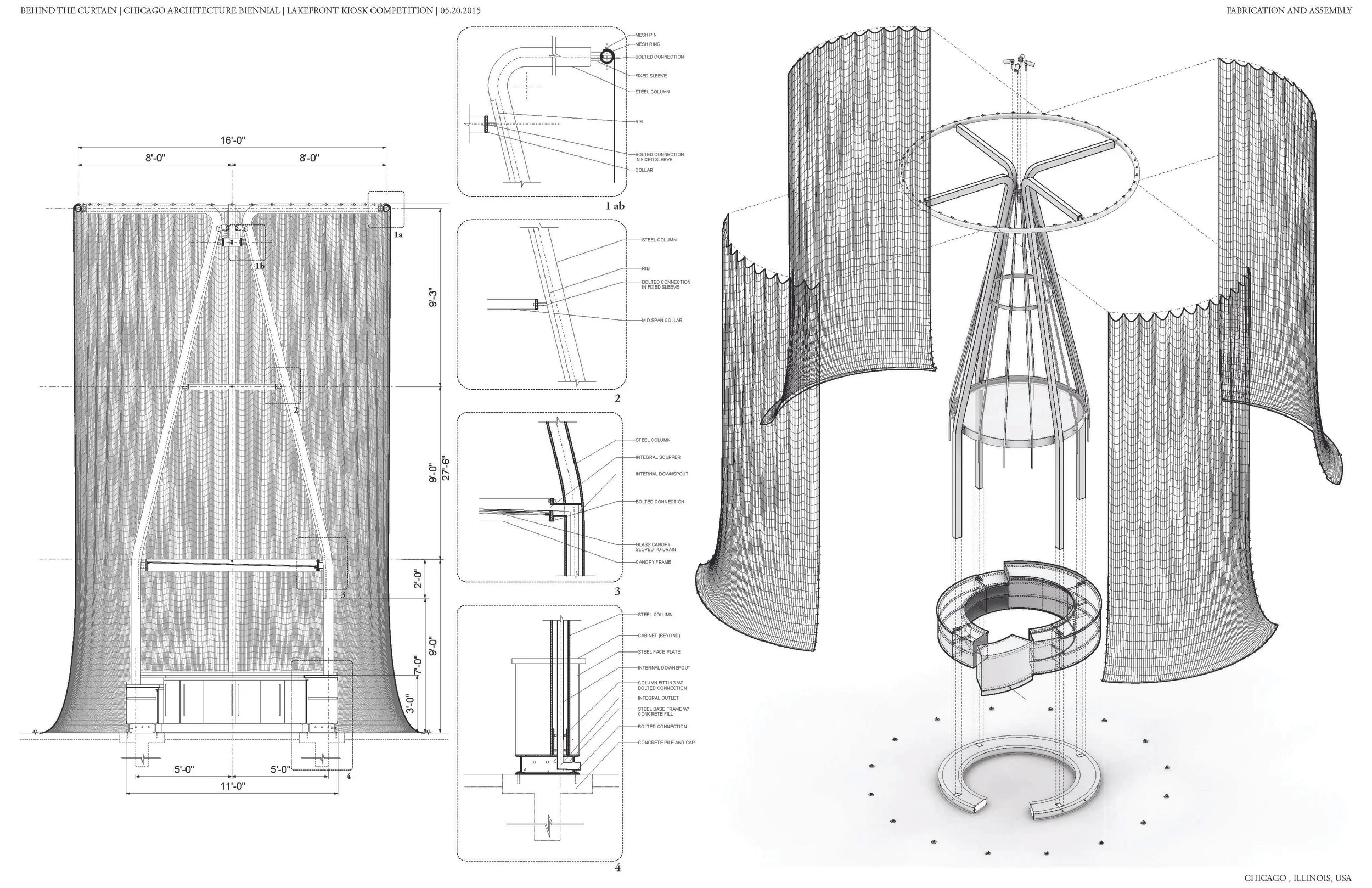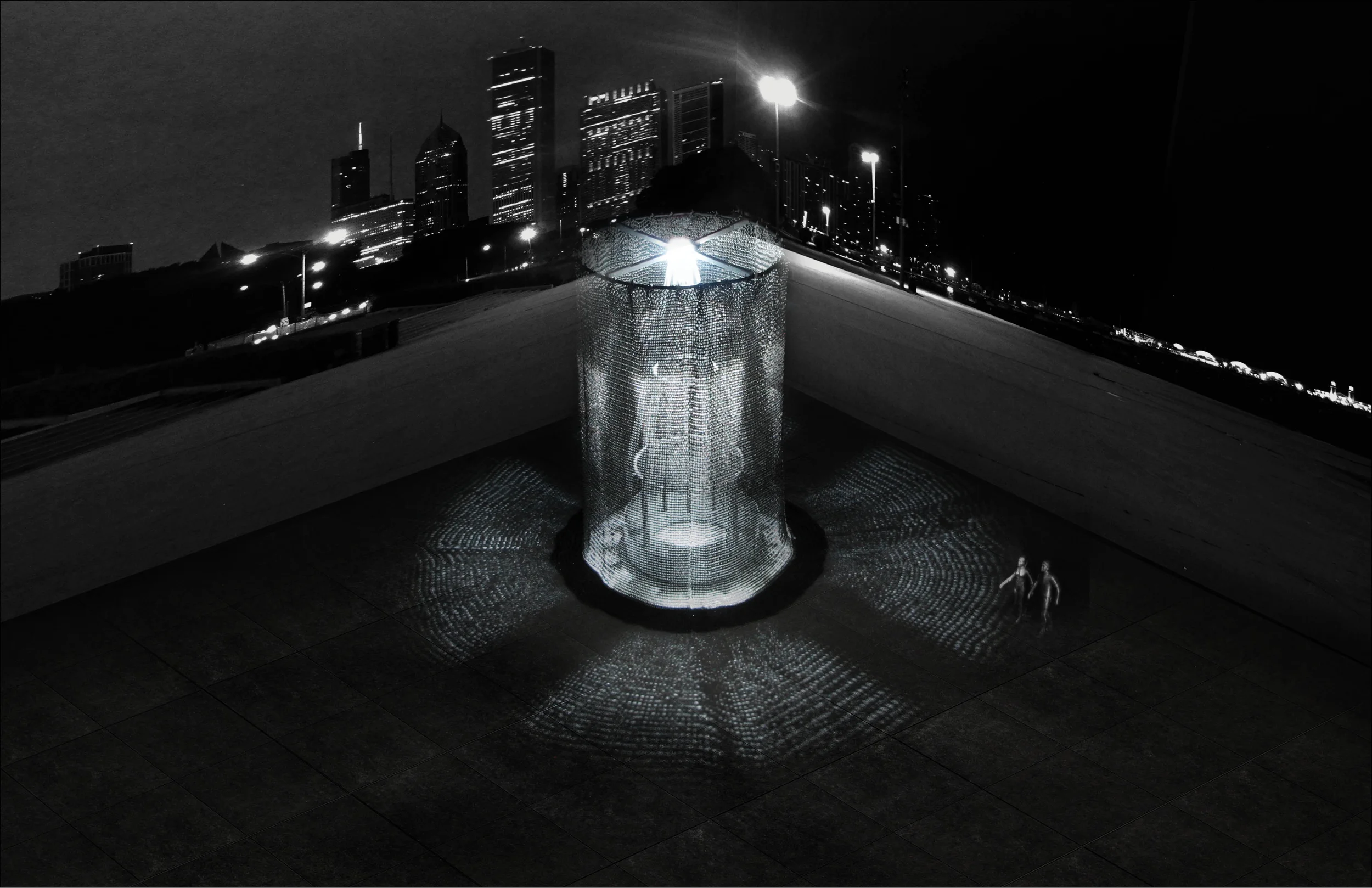Behind the Curtain
Finalist - Chicago Architectural Biennial Kiosk Competition 2015
In collaboration with Thomas Kelley & Chuck Paros
1. ON INTENTION, OR THE OCCULT MONUMENT
Like a small child’s not so inconspicuous hiding spot, this project is intent on concealing itself poorly. This is not to say that the project aims to present itself poorly, but rather, present itself in a manner which tries to conceal or mute, as opposed to embellish, its inherent qualities of monumentality, iconicity, and symbolism. To begin: look closely and you will see that our disguise is fairly superficial (i.e. skin deep). A thinly meshed veil conceals, but also attracts, an attenuated figure held within its loose fitting cylindrical body. Only after peeling back this veil, now a curtain, that the project reveals its function. Alas, it is simply a kiosk. Nothing more, nothing less. Still grand, however. Pull up a seat and transact your business.
2. ON HISTORY, OR THE ECONOMY OF SPECTACLE
The Exposition Universelle of 1889 unveiled the Eiffel Tower, a glorified entrance arch. The World’s Columbian Exposition of 1893 was saved from bankruptcy by George Ferris’ Wheel, essentially a vertical carousel. In 1939, the New York World’s Fair hoisted its visitors to a height of two-hundred-and-fifty feet to simulate the effects of falling with a parachute. It goes without saying that grandiosity and spectacle are often the main attractions of any public event. Fast forward to 2015, the first Chicago Architecture Biennial. Is spectacle still a desirable pursuit? Perhaps a more economical position is more favorable for the times we currently inhabit. The selection of a kiosk to speak as spectacle is a potentially futile request of such a modest architectural type. That said, given Chicago’s climate, the charge of spectacle lends itself to lifespan. If you are to look closely at function, the existing kiosks efficiently meet the needs of the various vendors that supply goods and services each year to the millions of visitors to Chicago’s lakefront. All summer long these modest huts are alive with energy, but for nine months of the year these once active spaces are shuttered closed to form a ghost town; a constant reminder that the magic of summer in Chicago has disappeared. Our proposal for a new kiosk does not seek to reinvent the type. In fact, it functions as easily and efficiently as the existing kiosks do, but it does so while providing alternative readings to what constitutes a spectacular year longinteraction. A veil dangles with its shadows cast onany given ground it occupies. The kiosk invites the casual passersby to join in its dance. Overall, the structure is more than just a place of commerce, but now a shy icon that tempts its audience to stare into and beyond.
3. ON FEATURES, OR AN ACT IN THREE PARTS
The kiosk assembly system is intentionally simple. The features are organized into three parts: (a) base, (b) frame, and (c) veil.
All parts are mechanically fastened to one another on site so the kiosk can be assembled and disassembled multiple times for easy transportation or storage.
Base:
The base is made of two component parts: base structure , and cabinetry.. The structure of the base is a 12’ diameter steel ring made of bent 8” C channelwith four column anchors attached to it. Diamond plate is welded to the steel frame as a finished surface. Thecabinetry is a simple assembly of a formed steel wall attached to the outer diameter of the base. The formed steel walls will have grommets located within each reveal to allow for flexibility in attaching banners and signage of various sizes to it. A steel counter is attached to the wall, making a space for storage carts to be located. When sited in sandy location base can be stabilized using sand augers
Frame:
The frame structure is made of the three components: Primary,Secondary, and Vail structure. The primary structure is made of four (4”x6”x35’) steel tubes bent into the same profile.. The four tubes are set into the four column anchors of the base. The secondary structure is made of two collar rings that lock the four columns together and stabilized the structure. The two collar rings are located at the midpoint anr top of structure. In addition to stabilizing the structure these two collar rings act as anchor points for the 2”x2” bent steel tube that forms the conical silhouette of the of the structure. A light is attached to the upper collar ring and the lower collar ring provides anchor points for a glass canopy for shade and cover. The Vail structure is an 18’ diameter steel ring made from bent (3”x6”) steel tube anchored to the ends of the four steel columns.
Veil:
Stainless steel coil mesh is attached toan equally spaced set of grommets that securely attach the steel mesh to the structure and produces the pleated curtains like quality of the kiosk. While having a visual delicacy the steel mesh of the veilwill have a rigidity that will allow the curtain to serve as a means to secure the kiosk in off hours and the off season. The extra length of the curtain allows it to elegantly bunch at the ground while open and then be pulled tight to the 12’ dia. base and locked during off hours and off seasons.






